Tunable Fano Resonance and Enhanced Sensing in a Simple Au/TiO2 Hybrid Metasurface
Abstract
1. Introduction
2. Structure and Theory Model
3. Results and Discussion
3.1. Tunable Fano Resonances in the Hybrid Metasurface
3.2. Sensing Enhancement Based on the Stub-Shaped Defect
4. Conclusions
Author Contributions
Funding
Conflicts of Interest
References
- Pendry, J.B.; Martin-Moreno, L.; Garcia-Vidal, F.J. Mimicking surface plasmons with structured surfaces. Science 2004, 305, 847–848. [Google Scholar] [CrossRef] [PubMed]
- Hibbins, A.P.; Evans, B.R.; Sambles, J.R. Experimental verification of designer surface plasmons. Science 2005, 308, 670–672. [Google Scholar] [CrossRef] [PubMed]
- Chang, D.E.; Sørensen, A.S.; Demler, E.A.; Lukin, M.D. A single-photon transistor using nanoscale surface plasmons. Nat. Phys. 2007, 3, 807–812. [Google Scholar] [CrossRef]
- Chong, M.C.; Reecht, G.; Bulou, H.; Boeglin, A.; Scheurer, F.; Mathevet, F.; Schull, G. Narrow-line single-molecule transducer between electronic circuits and surface plasmons. Phys. Rev. Lett. 2016, 116, 036802. [Google Scholar] [CrossRef] [PubMed]
- Lereu, A.L.; Zerrad, M.; Passian, A.; Amra, C. Surface plasmons and Bloch surface waves: Towards optimized ultra-sensitive optical sensors. Appl. Phys. Lett. 2017, 111, 011107. [Google Scholar] [CrossRef]
- He, Z.; Li, H.; Li, B.; Chen, Z.; Xu, H.; Zheng, M. Theoretical analysis of ultrahigh figure of merit sensing in plasmonic waveguides with a multimode stub. Opt. Lett. 2016, 41, 5206–5209. [Google Scholar] [CrossRef] [PubMed]
- Zhan, S.; Li, H.; He, Z.; Li, B.; Chen, Z.; Xu, H. Sensing analysis based on plasmon induced transparency in nanocavity-coupled waveguide. Opt. Express 2015, 23, 20313–20320. [Google Scholar] [CrossRef]
- Fedeli, L.; Sgattoni, A.; Cantono, G.; Garzella, D.; Réau, F.; Prencipe, I.; Macchi, A. Electron acceleration by relativistic surface plasmons in laser-grating interaction. Phys. Rev. Lett. 2016, 116, 015001. [Google Scholar] [CrossRef]
- Zhan, S.; Xiong, J.; Nie, G.; Wu, S.; Hu, J.; Wu, X.; Liu, Y. Steady State Luminescence Enhancement in Plasmon Coupled Core/Shell Upconversion Nanoparticles. Adv. Mater. Interfaces 2019, 6, 1802089. [Google Scholar] [CrossRef]
- Guzzinati, G.; Béché, A.; Lourenco-Martins, H.; Martin, J.; Kociak, M.; Verbeeck, J. Probing the symmetry of the potential of localized surface plasmon resonances with phase-shaped electron beams. Nat. Commun. 2017, 8, 14999. [Google Scholar] [CrossRef]
- Gao, E.; Liu, Z.; Li, H.; Xu, H.; Zhang, Z.; Luo, X.; Zhou, F. Dynamically tunable dual plasmon-induced transparency and absorption based on a single-layer patterned graphene metamaterial. Opt. Express 2019, 27, 13884–13894. [Google Scholar] [CrossRef] [PubMed]
- Xu, H.; Li, H.; He, Z.; Chen, Z.; Zheng, M.; Zhao, M. Theoretical analysis of optical properties and sensing in a dual-layer asymmetric metamaterial. Opt. Commun. 2018, 407, 250–254. [Google Scholar] [CrossRef]
- Murray, W.A.; Suckling, J.R.; Barnes, W.L. Overlayers on silver nanotriangles: Field confinement and spectral position of localized surface plasmon resonances. Nano Lett. 2006, 6, 1772–1777. [Google Scholar] [CrossRef] [PubMed]
- Qin, F.; Chen, Z.; Chen, X.; Yi, Z.; Yao, W.; Duan, T.; Yi, Y. A Tunable Triple-Band Near-Infrared Metamaterial Absorber Based on Au Nano-Cuboids Array. Nanomaterials 2020, 10, 207. [Google Scholar] [CrossRef] [PubMed]
- He, Z.; Li, H.; Zhan, S.; Cao, G.; Li, B. Combined theoretical analysis for plasmon-induced transparency in waveguide systems. Opt. Lett. 2014, 39, 5543–5546. [Google Scholar] [CrossRef] [PubMed]
- Zhan, S.; Li, H.; Cao, G.; He, Z.; Li, B.; Yang, H. Slow light based on plasmon-induced transparency in dual-ring resonator-coupled MDM waveguide system. J. Phys. D Appl. Phys. 2014, 47, 205101. [Google Scholar] [CrossRef]
- Wang, Y.; Qin, F.; Yi, Z.; Chen, X.; Zhou, Z.; Yang, H.; Yi, Y. Effect of slit width on surface plasmon resonance. Results Phys. 2019, 15, 102711. [Google Scholar] [CrossRef]
- He, Z.; Zhao, J.; Lu, H. Tunable nonreciprocal reflection and its stability in a non-PT-symmetric plasmonic resonators coupled waveguide systems. Appl. Phys. Express 2020, 13, 012009. [Google Scholar] [CrossRef]
- He, Z.; Peng, Y.; Li, B.; Chen, Z.; Xu, H.; Zheng, M.; Li, H. Aspect ratio control and sensing applications for a slot waveguide with a multimode stub. Appl. Phys. Express 2016, 9, 072002. [Google Scholar] [CrossRef]
- Shafiei, F.; Monticone, F.; Le, K.Q.; Liu, X.X.; Hartsfield, T.; Alù, A.; Li, X. A subwavelength plasmonic metamolecule exhibiting magnetic-based optical Fano resonance. Nat. Nanotechnol. 2013, 8, 95. [Google Scholar] [CrossRef]
- Rahmani, M.; Luk’yanchuk, B.; Hong, M. Fano resonance in novel plasmonic nanostructures. Laser Photonics Rev. 2013, 7, 329–349. [Google Scholar] [CrossRef]
- Cao, G.; Li, H.; Deng, Y.; Zhan, S.; He, Z.; Li, B. Plasmon-induced transparency in a single multimode stub resonator. Opt. Express 2014, 22, 25215–25223. [Google Scholar] [CrossRef] [PubMed]
- Xu, H.; Li, H.; He, Z.; Chen, Z.; Zheng, M.; Zhao, M. Dual tunable plasmon-induced transparency based on silicon–air grating coupled graphene structure in terahertz metamaterial. Opt. Express 2017, 25, 20780–20790. [Google Scholar] [CrossRef] [PubMed]
- Zhang, B.; Li, H.; Xu, H.; Zhao, M.; Xiong, C.; Liu, C.; Wu, K. Absorption and slow-light analysis based on tunable plasmon-induced transparency in patterned graphene metamaterial. Opt. Express 2019, 27, 3598–3608. [Google Scholar] [CrossRef] [PubMed]
- Wang, Y.; Chen, Z.; Xu, D.; Yi, Z.; Chen, X.; Chen, J.; Yi, Y. Triple-band perfect metamaterial absorber with good operating angle polarization tolerance based on split ring arrays. Results Phys. 2020, 16, 102951. [Google Scholar] [CrossRef]
- Chen, Z.; Li, H.; Zhan, S.; He, Z.; Li, B.; Xu, H. Sensing characteristics based on Fano resonance in rectangular ring waveguide. Opt. Commun. 2015, 356, 373–377. [Google Scholar] [CrossRef]
- Zhang, S.; Genov, D.A.; Wang, Y.; Liu, M.; Zhang, X. Plasmon-induced transparency in metamaterials. Phys. Rev. Lett. 2008, 101, 047401. [Google Scholar] [CrossRef]
- Kekatpure, R.D.; Barnard, E.S.; Cai, W.; Brongersma, M. Phase-coupled plasmon-induced transparency. Phys. Rev. Lett. 2010, 104, 243902. [Google Scholar] [CrossRef]
- Liu, C.; Li, H.; Xu, H.; Zhao, M.; Xiong, C.; Zhang, B.; Wu, K. Tunable plasmon-induced transparency absorbers based on few-layer black phosphorus ribbon metamaterials. J. Opt. Soc. Am. B 2019, 36, 3060–3065. [Google Scholar] [CrossRef]
- Liu, C.; Li, H.; Xu, H.; Zhao, M.; Xiong, C.; Zhang, B.; Wu, K. Slow light effect based on tunable plasmon-induced transparency of monolayer black phosphorus. J. Phys. D Appl. Phys. 2019, 52, 405203. [Google Scholar] [CrossRef]
- Ma, R.M.; Oulton, R.F.; Sorger, V.J.; Bartal, G.; Zhang, X. Room-temperature sub-diffraction-limited plasmon laser by total internal reflection. Nat. Mater. 2011, 10, 110–113. [Google Scholar] [CrossRef] [PubMed]
- Pu, M.B.; Wang, C.T.; Wang, Y.Q.; Luo, X.G. Subwavelength electromagnetics below the diffraction limit. Acta Phys. Sin. 2017, 66, 144101. [Google Scholar]
- Ebbesen, T.W.; Lezec, H.J.; Ghaemi, H.F.; Thio, T.; Wolff, P.A. Extraordinary optical transmission through sub-wavelength hole arrays. Nature 1998, 391, 667–669. [Google Scholar] [CrossRef]
- Martin-Moreno, L.; Garcia-Vidal, F.J.; Lezec, H.J.; Pellerin, K.M.; Thio, T.; Pendry, J.B.; Ebbesen, T.W. Theory of extraordinary optical transmission through subwavelength hole arrays. Phys. Rev. Lett. 2001, 86, 1114. [Google Scholar] [CrossRef]
- Chen, Z.; Li, P.; Zhang, S.; Chen, Y.; Liu, P.; Duan, H. Enhanced extraordinary optical transmission and refractive-index sensing sensitivity in tapered plasmonic nanohole arrays. Nanotechnology 2019, 30, 335201. [Google Scholar] [CrossRef]
- Safavi-Naeini, A.H.; Alegre, T.P.M.; Chan, J.; Eichenfield, M.; Winger, M.; Lin, Q.; Painter, O. Electromagnetically induced transparency and slow light with optomechanics. Nature 2011, 472, 69–73. [Google Scholar] [CrossRef]
- Gu, J.; Singh, R.; Liu, X.; Zhang, X.; Ma, Y.; Zhang, S.; Taylor, A.J. Active control of electromagnetically induced transparency analogue in terahertz metamaterials. Nat. Commun. 2012, 3, 1151. [Google Scholar] [CrossRef]
- Liu, N.; Langguth, L.; Weiss, T.; Kästel, J.; Fleischhauer, M.; Pfau, T.; Giessen, H. Plasmonic analogue of electromagnetically induced transparency at the Drude damping limit. Nat. Mater. 2009, 8, 758–762. [Google Scholar] [CrossRef]
- Cao, G.; Li, H.; Zhan, S.; Xu, H.; Liu, Z.; He, Z.; Wang, Y. Formation and evolution mechanisms of plasmon-induced transparency in MDM waveguide with two stub resonators. Opt. Express 2013, 21, 9198–9205. [Google Scholar] [CrossRef]
- Cao, G.; Li, H.; Zhan, S.; He, Z.; Guo, Z.; Xu, X.; Yang, H. Uniform theoretical description of plasmon-induced transparency in plasmonic stub waveguide. Opt. Lett. 2014, 39, 216–219. [Google Scholar] [CrossRef]
- Zhan, S.; Li, H.; Cao, G.; He, Z.; Li, B.; Xu, H. Theoretical analysis and applications on nano-block loaded rectangular ring. J. Opt. Soc. Am. A 2014, 31, 2263–2267. [Google Scholar] [CrossRef] [PubMed]
- Xu, H.; Zhao, M.; Zheng, M.; Xiong, C.; Zhang, B.; Peng, Y.; Li, H. Dual plasmon-induced transparency and slow light effect in monolayer graphene structure with rectangular defects. J. Phys. D Appl. Phys. 2018, 52, 025104. [Google Scholar] [CrossRef]
- Liu, N.; Weiss, T.; Mesch, M.; Langguth, L.; Eigenthaler, U.; Hirscher, M.; Giessen, H. Planar metamaterial analogue of electromagnetically induced transparency for plasmonic sensing. Nano Lett. 2010, 10, 1103–1107. [Google Scholar] [CrossRef] [PubMed]
- Eftekhari, F.; Escobedo, C.; Ferreira, J.; Duan, X.; Girotto, E.M.; Brolo, A.G.; Sinton, D. Nanoholes as nanochannels: Flow-through plasmonic sensing. Anal. Chem. 2009, 81, 4308–4311. [Google Scholar] [CrossRef]
- Rindzevicius, T.; Alaverdyan, Y.; Dahlin, A.; Höök, F.; Sutherland, D.S.; Käll, M. Plasmonic sensing characteristics of single nanometric holes. Nano Lett. 2005, 5, 2335–2339. [Google Scholar] [CrossRef]
- Luk’yanchuk, B.; Zheludev, N.I.; Maier, S.A.; Halas, N.J.; Nordlander, P.; Giessen, H.; Chong, C.T. The Fano resonance in plasmonic nanostructures and metamaterials. Nat. Mater. 2010, 9, 707–715. [Google Scholar] [CrossRef]
- Singh, R.; Cao, W.; Al-Naib, I.; Cong, L.; Withayachumnankul, W.; Zhang, W. Ultrasensitive terahertz sensing with high-Q Fano resonances in metasurfaces. Appl. Phys. Lett. 2014, 105, 171101. [Google Scholar] [CrossRef]
- Abujetas, D.R.; Sáenz, J.J.; Sánchez-Gil, J.A. Narrow Fano resonances in Si nanocylinder metasurfaces: Refractive index sensing. J. Appl. Phys. 2019, 125, 183103. [Google Scholar] [CrossRef]
- Gerislioglu, B.; Dong, L.; Ahmadivand, A.; Hu, H.; Nordlander, P.; Halas, N.J. Monolithic metal dimer-on-film structure: New plasmonic properties introduced by the underlying metal. Nano Lett. 2020, 20, 2087–2093. [Google Scholar] [CrossRef]
- Lu, H.; Liu, X.; Mao, D.; Wang, G. Plasmonic nanosensor based on Fano resonance in waveguide-coupled resonators. Opt. Lett. 2012, 37, 3780–3782. [Google Scholar] [CrossRef]
- Zhan, S.; Peng, Y.; He, Z.; Li, B.; Chen, Z.; Xu, H.; Li, H. Tunable nanoplasmonic sensor based on the asymmetric degree of Fano resonance in MDM waveguide. Sci. Rep. 2016, 6, 22428. [Google Scholar] [CrossRef] [PubMed]
- Tang, W.; Wang, L.; Chen, X.; Liu, C.; Yu, A.; Lu, W. Dynamic metamaterial based on the graphene split ring high-Q Fano-resonnator for sensing applications. Nanoscale 2016, 8, 15196–15204. [Google Scholar] [CrossRef] [PubMed]
- Zhang, Y.; Li, T.; Zeng, B.; Zhang, H.; Lv, H.; Huang, X.; Azad, A.K. A graphene based tunable terahertz sensor with double Fano resonances. Nanoscale 2015, 7, 12682–12688. [Google Scholar] [CrossRef] [PubMed]
- Cen, C.; Chen, Z.; Xu, D.; Jiang, L.; Chen, X.; Yi, Z.; Yi, Y. High Quality Factor, High Sensitivity Metamaterial Graphene—Perfect Absorber Based on Critical Coupling Theory and Impedance Matching. Nanomaterials 2020, 10, 95. [Google Scholar] [CrossRef] [PubMed]
- Liu, H.; Zheng, L.; Ma, P.; Zhong, Y.; Liu, B.; Chen, X.; Liu, H. Metasurface generated polarization insensitive Fano resonance for high-performance refractive index sensing. Opt. Express 2019, 27, 13252–13262. [Google Scholar] [CrossRef]
- Klar, T.; Perner, M.; Grosse, S.; Von Plessen, G.; Spirkl, W.; Feldmann, J. Surface-plasmon resonances in single metallic nanoparticles. Phys. Rev. Lett. 1998, 80, 4249. [Google Scholar] [CrossRef]
- Ahmadivand, A.; Gerislioglu, B.; Ramezani, Z. Gated graphene island-enabled tunable charge transfer plasmon terahertz metamodulator. Nanoscale 2019, 11, 8091–8095. [Google Scholar] [CrossRef]
- Liu, N.; Mesch, M.; Weiss, T.; Hentschel, M.; Giessen, H. Infrared perfect absorber and its application as plasmonic sensor. Nano Lett. 2010, 10, 2342–2348. [Google Scholar] [CrossRef]
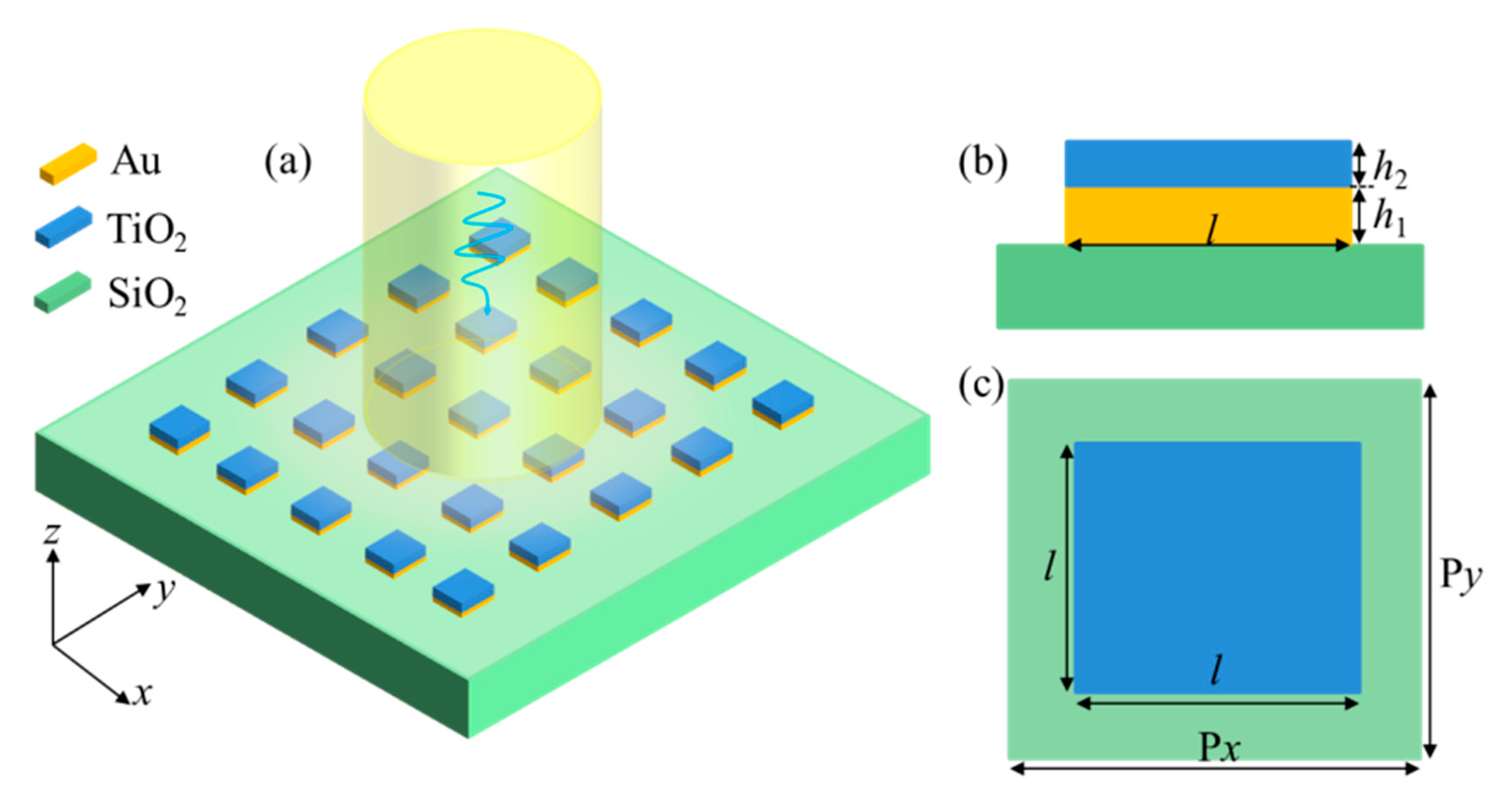
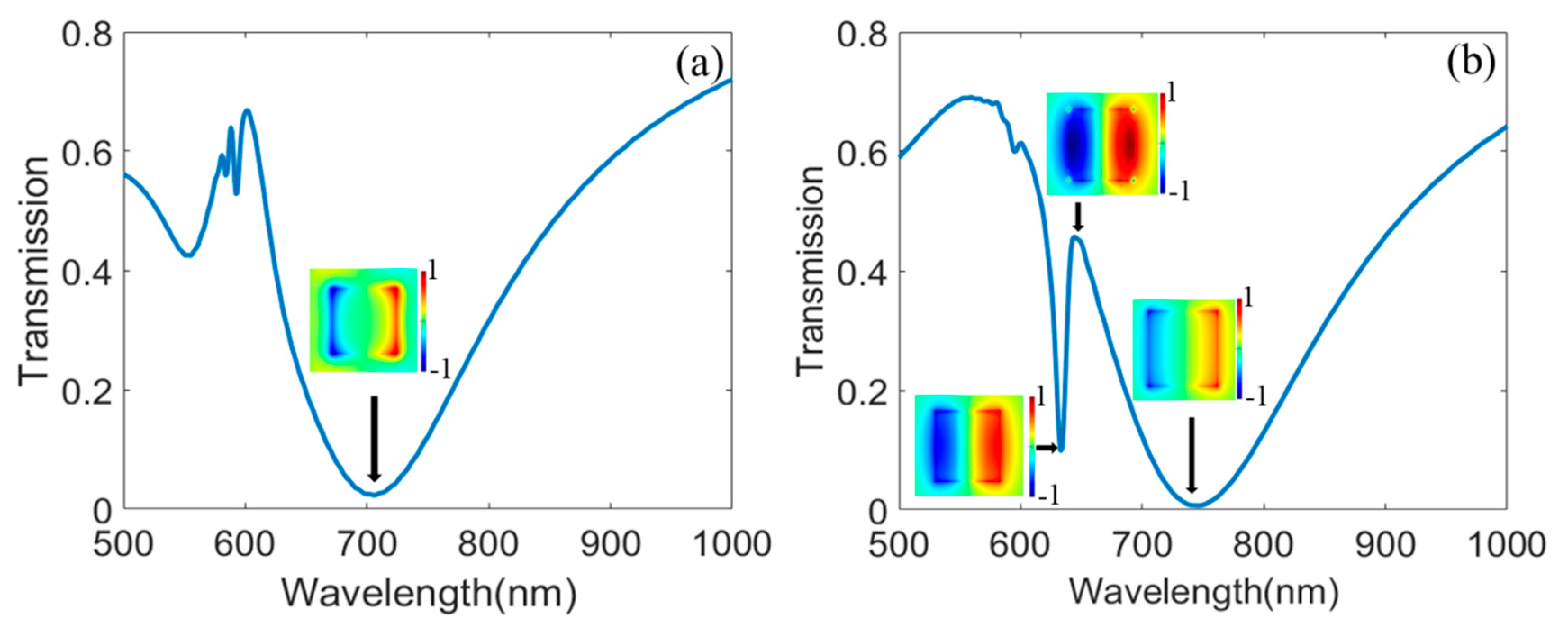

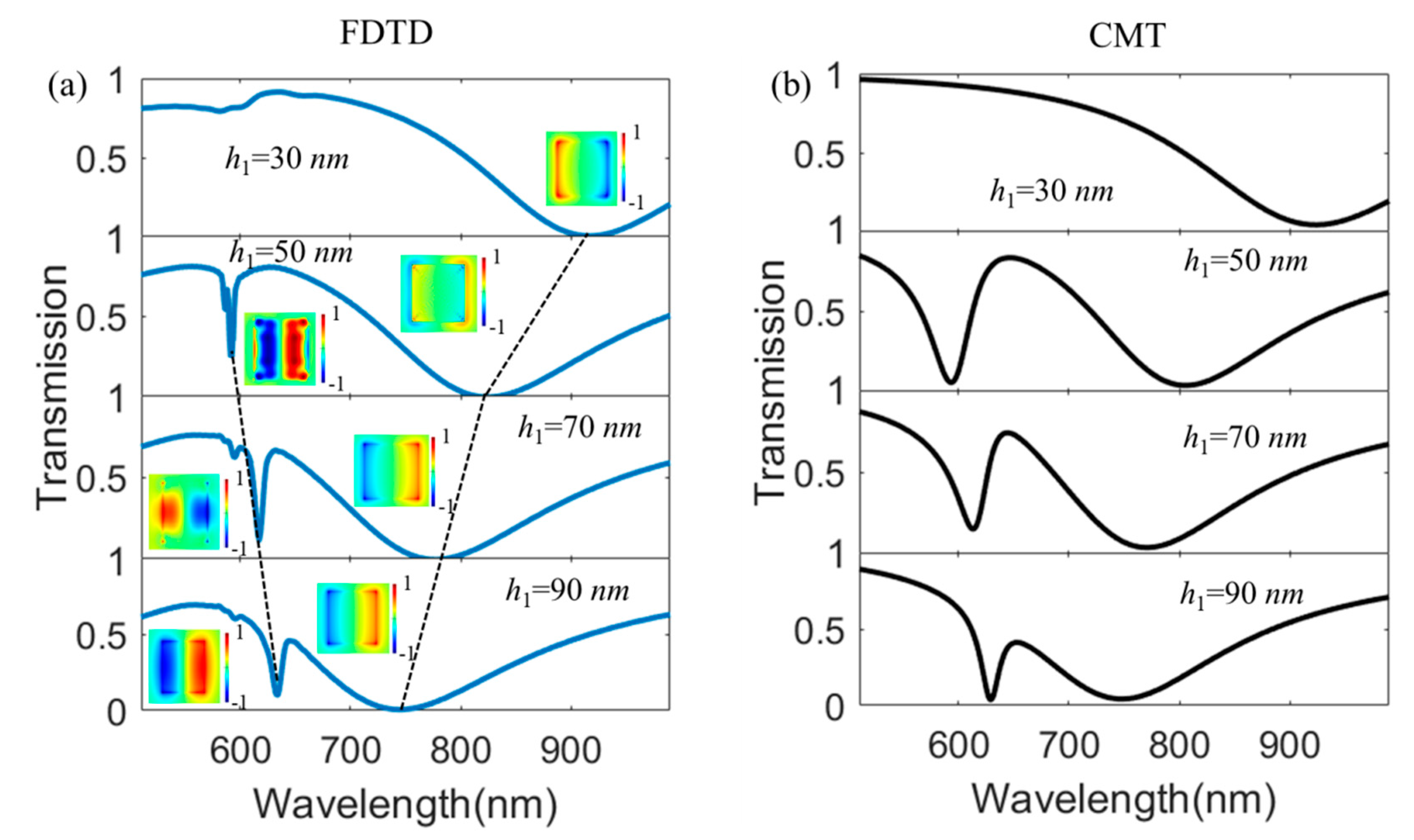

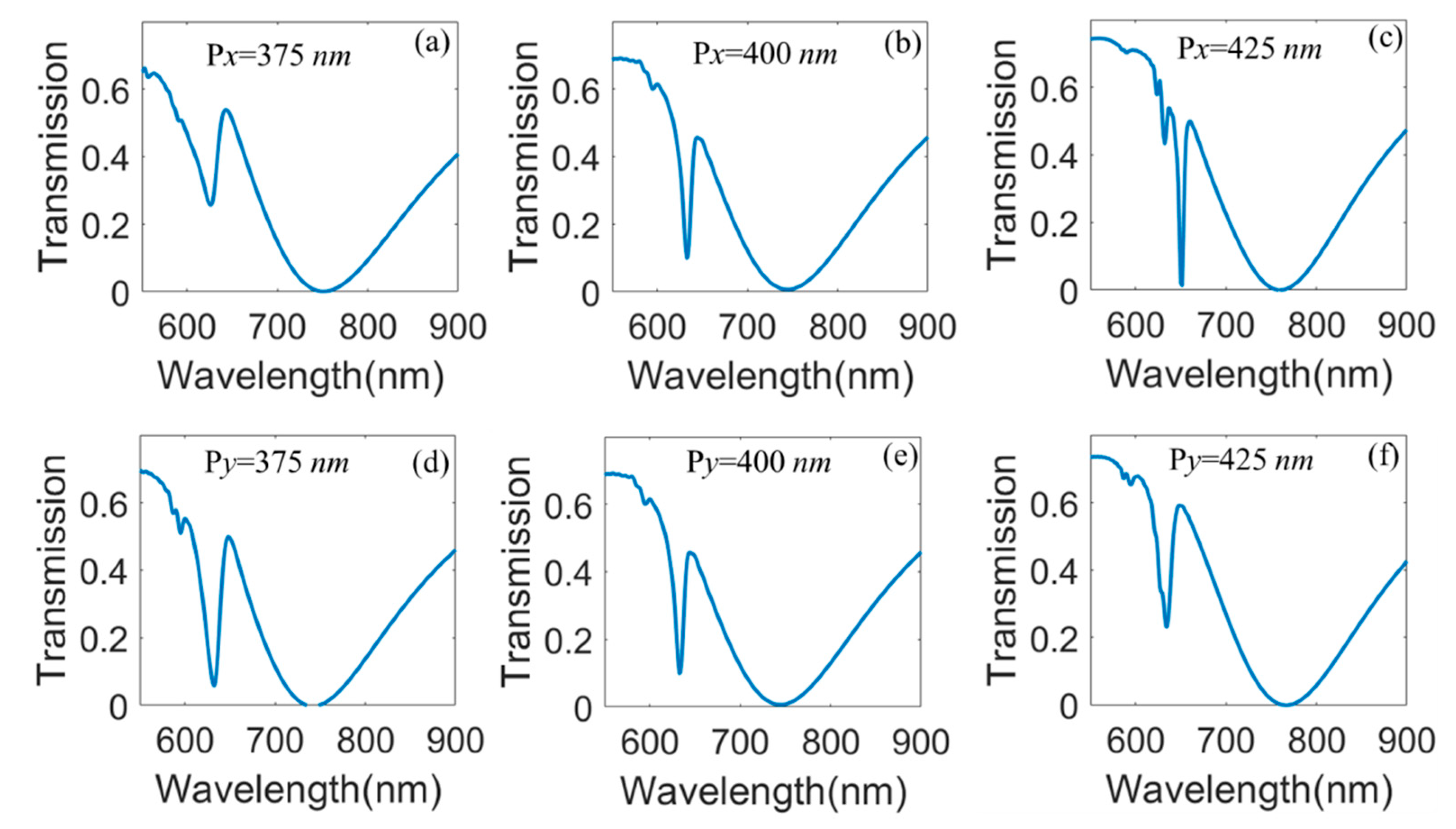

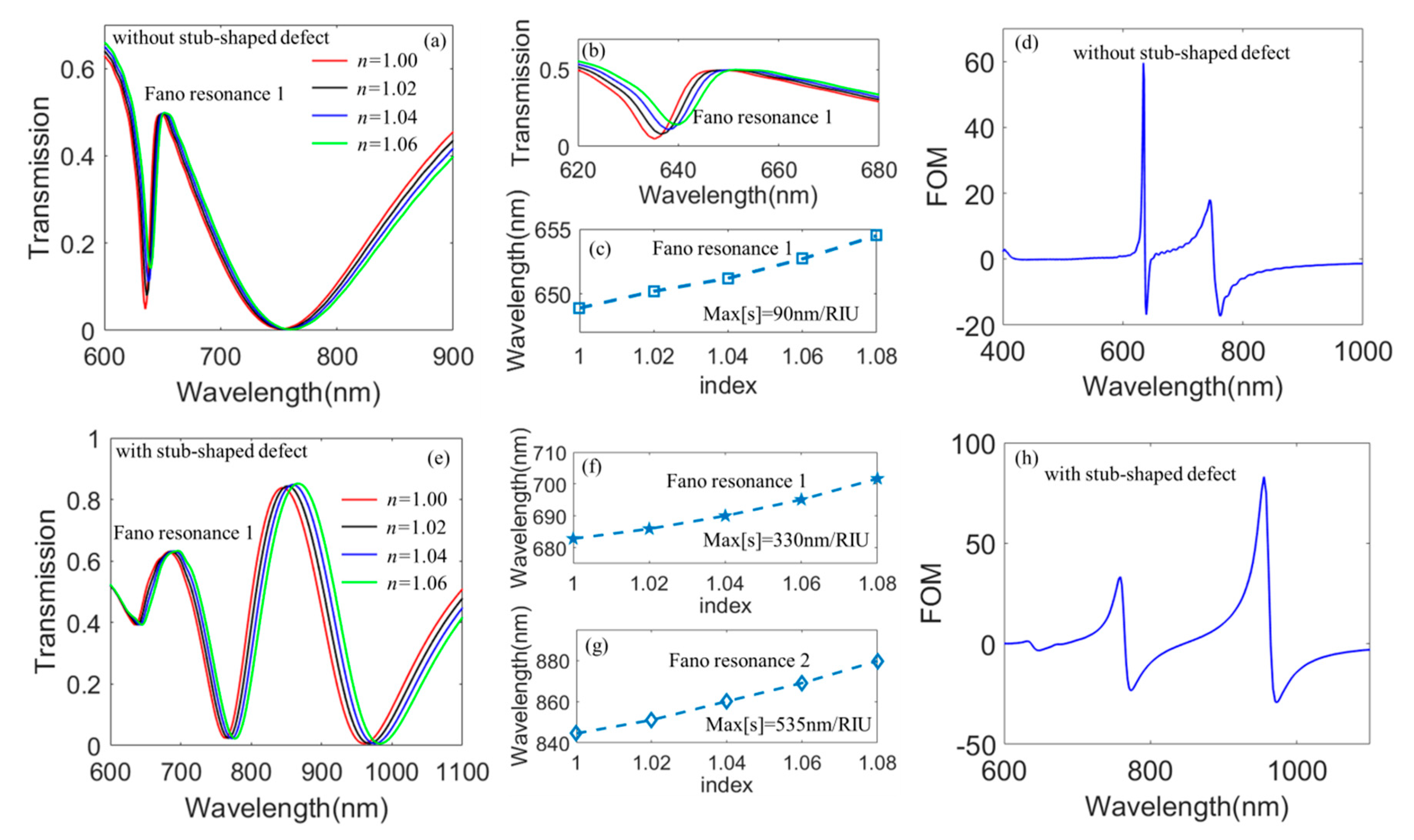
| h1 (nm) | h2 (nm) | |||||||
|---|---|---|---|---|---|---|---|---|
| 30 | 50 | 70 | 90 | 30 | 50 | 70 | 90 | |
| QF | 0.4 | 4.6 | 8.5 | 15.3 | 14.0 | 15.3 | 10.2 | 12.5 |
| td (fs) | 10.7 | 14.0 | 19.9 | 28.1 | 27.3 | 28.1 | 23.7 | 25.0 |
| d (nm) | b (nm) | |||||||
|---|---|---|---|---|---|---|---|---|
| 25 | 50 | 75 | 100 | 25 | 50 | 75 | ||
| QF | Fano 1 | 12.4 | 9.3 | 9.3 | 8.9 | 9.1 | 11.1 | 16.3 |
| Fano 2 | 23.4 | 6.8 | 3.6 | 2.4 | 6.7 | 7.7 | 7.7 | |
| td (fs) | Fano 1 | 32.7 | 24.4 | 24.3 | 23.5 | 24.0 | 29.5 | 38.5 |
| Fano 2 | 46.4 | 21.5 | 15.0 | 12.1 | 20.2 | 23.1 | 23.2 | |
© 2020 by the authors. Licensee MDPI, Basel, Switzerland. This article is an open access article distributed under the terms and conditions of the Creative Commons Attribution (CC BY) license (http://creativecommons.org/licenses/by/4.0/).
Share and Cite
He, Z.; Xue, W.; Cui, W.; Li, C.; Li, Z.; Pu, L.; Feng, J.; Xiao, X.; Wang, X.; Li, a.G. Tunable Fano Resonance and Enhanced Sensing in a Simple Au/TiO2 Hybrid Metasurface. Nanomaterials 2020, 10, 687. https://doi.org/10.3390/nano10040687
He Z, Xue W, Cui W, Li C, Li Z, Pu L, Feng J, Xiao X, Wang X, Li aG. Tunable Fano Resonance and Enhanced Sensing in a Simple Au/TiO2 Hybrid Metasurface. Nanomaterials. 2020; 10(4):687. https://doi.org/10.3390/nano10040687
Chicago/Turabian StyleHe, Zhihui, Weiwei Xue, Wei Cui, Chunjiang Li, Zhenxiong Li, Lihui Pu, Jiaojiao Feng, Xintao Xiao, Xuyang Wang, and and Gang Li. 2020. "Tunable Fano Resonance and Enhanced Sensing in a Simple Au/TiO2 Hybrid Metasurface" Nanomaterials 10, no. 4: 687. https://doi.org/10.3390/nano10040687
APA StyleHe, Z., Xue, W., Cui, W., Li, C., Li, Z., Pu, L., Feng, J., Xiao, X., Wang, X., & Li, a. G. (2020). Tunable Fano Resonance and Enhanced Sensing in a Simple Au/TiO2 Hybrid Metasurface. Nanomaterials, 10(4), 687. https://doi.org/10.3390/nano10040687




